Quad/Graphics Bundle
Who Really Controls Quad/Graphics?
Ever wondered who's truly calling the shots at Quad/Graphics, the marketing experience company reshaping how brands connect with consumers? Unraveling the Quad/Graphics SWOT Analysis is just the beginning when it comes to understanding this industry leader. Knowing the ownership structure of a company is critical for any investor or strategist. This article provides a comprehensive look at who owns Quad/Graphics.
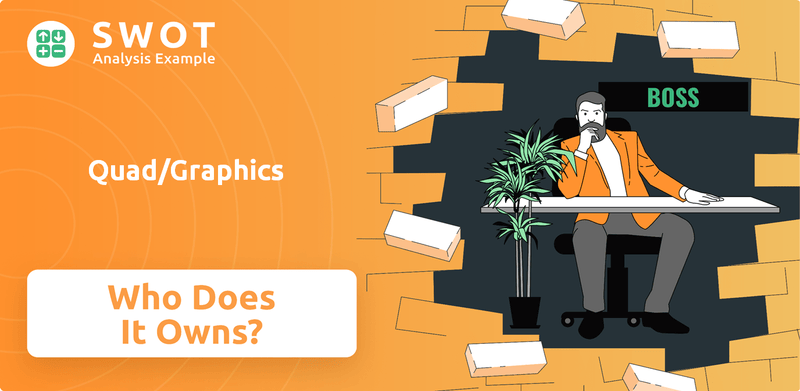
From its roots as a printing company to its current status as a marketing solutions provider, understanding the evolution of Quad/Graphics ownership is key. This exploration of Quad/Graphics ownership will examine the influence of key investors, the role of public shareholders, and the impact of leadership changes. Whether you're researching Quad/Graphics stock, or trying to understand the company's financial information, this is where to start.
Who Founded Quad/Graphics?
The printing company, Quad/Graphics, was established in 1971 by Harry V. Quadracci. His background and expertise in the printing industry were instrumental in shaping the company's initial focus on delivering high-quality printing services. The early years of Quad Graphics were marked by Quadracci's vision and leadership, setting the stage for its future growth.
At its inception, Quad/Graphics was a privately held entity. Therefore, specific details about the initial equity splits or shareholding percentages are not readily available in public records. However, it is understood that Harry V. Quadracci held the primary ownership and control of the company during its founding phase.
Early ownership structures of private companies often involve the founder maintaining a significant stake to ensure their vision is executed. There is no widely publicized information regarding notable early backers or angel investors who acquired stakes during the initial phase of Quad/Graphics. This suggests a largely self-funded or conventionally financed start, with the founder at the helm of ownership.
Harry V. Quadracci's vision was crucial in establishing Quad/Graphics. His leadership was key to the company's early growth and its focus on quality printing.
As a private company initially, detailed ownership information isn't publicly available. The founder likely held a significant ownership stake.
The company's early financing likely came from Quadracci himself or conventional sources, rather than external investors.
Quadracci's vision was inherently reflected in the distribution of control. He was the driving force behind the company's establishment.
Agreements like vesting schedules and buy-sell clauses would have been internal matters. Details about initial ownership disputes are not publicly documented.
The company's early growth was primarily driven by Quadracci's leadership and his focus on high-quality printing services.
Understanding the early ownership of Quad/Graphics provides insights into its foundational principles. The company's initial structure, with Harry V. Quadracci at the helm, set the stage for its development in the printing industry. For more details on the company's strategic direction, you might find this article about the Target Market of Quad/Graphics useful.
- Harry V. Quadracci founded Quad/Graphics in 1971.
- The founder held primary ownership and control initially.
- Early financing was likely self-funded or from conventional sources.
- Details of early ownership structures are not publicly available.
Quad/Graphics SWOT Analysis
- Complete SWOT Breakdown
- Fully Customizable
- Editable in Excel & Word
- Professional Formatting
- Investor-Ready Format
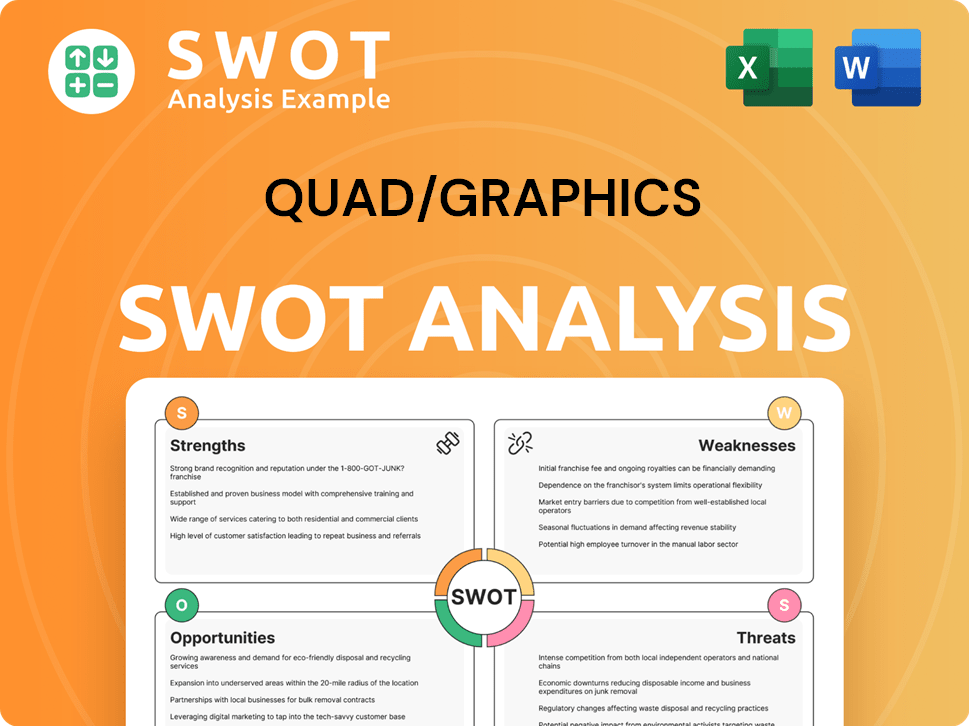
How Has Quad/Graphics’s Ownership Changed Over Time?
The evolution of Quad/Graphics ownership marks a pivotal shift from private to public. The company's initial public offering (IPO) on July 8, 2010, listed its Class A common stock on the New York Stock Exchange under the ticker symbol 'QUAD'. This transition broadened the ownership base, bringing in institutional and individual investors.
As of early 2025, the ownership structure of Quad/Graphics includes a mix of institutional investors, mutual funds, and the Quadracci family. Institutional investors hold a significant portion of the outstanding shares. The Quadracci family maintains influence, often through Class B shares that carry super-voting rights.
| Ownership Event | Date | Impact |
|---|---|---|
| IPO | July 8, 2010 | Transitioned from private to public; diversified ownership. |
| Institutional Investment | Ongoing (as of March 31, 2025) | Significant holdings by firms like Vanguard and BlackRock. |
| Family Holdings | Ongoing | Quadracci family retains influence through voting rights. |
Major shareholders of Quad/Graphics include institutional investors such as Vanguard Group Inc. and BlackRock Inc. as of March 31, 2025. The Quadracci family also holds a significant stake. This ownership structure, particularly the shift to public ownership, has influenced company strategy, increasing market scrutiny and the need for transparency. However, the family's continued influence balances public market demands with the preservation of the founding vision.
Understanding the ownership structure of Quad/Graphics is crucial for investors and stakeholders.
- The IPO in 2010 was a major event, changing the ownership landscape.
- Institutional investors hold a significant portion of the company's stock.
- The Quadracci family maintains influence through voting rights.
- This balance impacts the company's strategic direction and market performance.
Quad/Graphics PESTLE Analysis
- Covers All 6 PESTLE Categories
- No Research Needed – Save Hours of Work
- Built by Experts, Trusted by Consultants
- Instant Download, Ready to Use
- 100% Editable, Fully Customizable
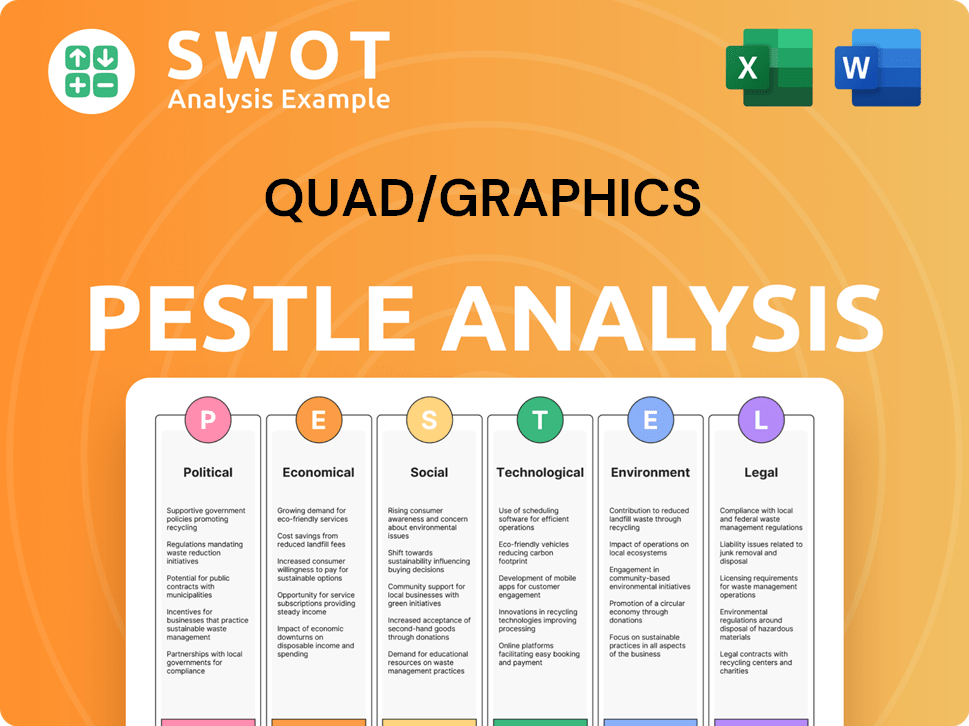
Who Sits on Quad/Graphics’s Board?
The current board of directors of Quad/Graphics includes a mix of individuals representing major shareholders, the founding family, and independent members. As of early 2025, the board includes members of the Quadracci family, such as Joel Quadracci, who serves as Chairman, President, and CEO. This demonstrates a direct link between the founding family's ownership and their representation and leadership on the board. This structure ensures that the founding vision and long-term strategy, as interpreted by the Quadracci family, continue to shape decision-making within the company.
The composition of the board reflects the company's ownership structure, with key figures from the Quadracci family holding significant positions. The presence of independent directors also suggests a balance between family influence and external oversight, which is crucial for maintaining corporate governance standards. The board's role is to oversee the company's strategic direction, financial performance, and overall management, ensuring that it operates in the best interests of all shareholders.
| Board Member | Title | Affiliation |
|---|---|---|
| Joel Quadracci | Chairman, President, and CEO | Quadracci Family |
| Thomas A. Quadracci | Director | Quadracci Family |
| Other Directors | Independent Directors | Various |
Quad/Graphics utilizes a dual-class share structure, which significantly affects voting power. The company has Class A Common Stock and Class B Common Stock. The Class B Common Stock, mainly held by the Quadracci family, has super-voting rights, typically ten votes per share, compared to one vote per share for the Class A Common Stock. This structure gives the Quadracci family substantial control and voting power, allowing them to maintain strategic direction and significant influence over major corporate decisions, even if their economic ownership percentage is lower than institutional investors. Understanding Brief History of Quad/Graphics provides further context.
The dual-class structure gives the Quadracci family significant control. This structure helps the family maintain strategic control over the company. The impact of activist investor campaigns is inherently mitigated.
- Super-voting rights for Class B shares.
- Outsized control for the Quadracci family.
- Protection against hostile takeovers.
- Influence over major corporate decisions.
Quad/Graphics Business Model Canvas
- Complete 9-Block Business Model Canvas
- Effortlessly Communicate Your Business Strategy
- Investor-Ready BMC Format
- 100% Editable and Customizable
- Clear and Structured Layout
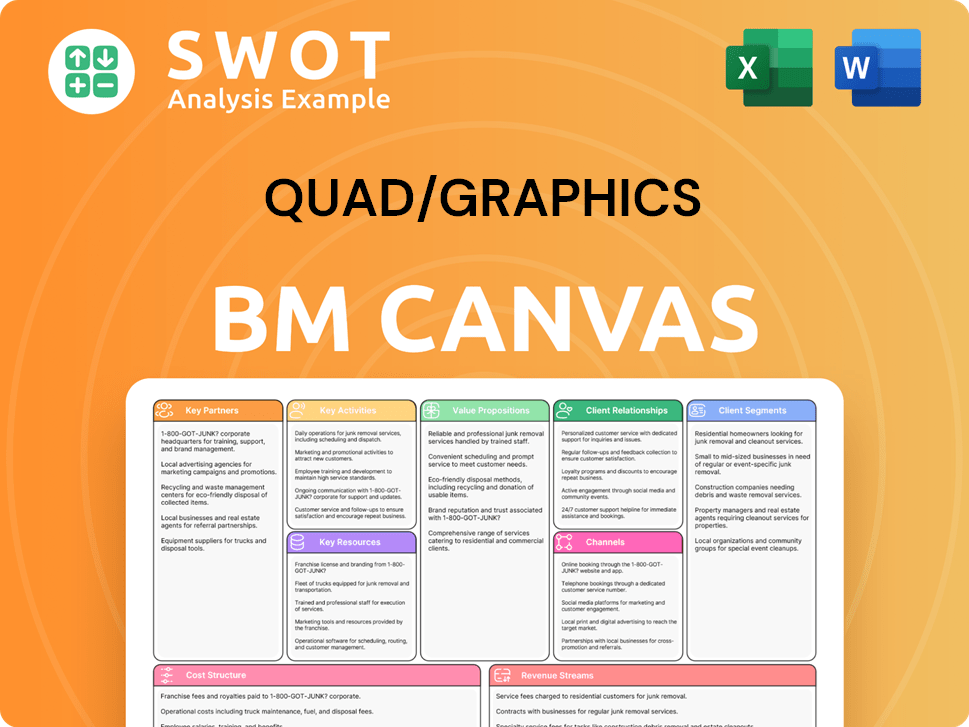
What Recent Changes Have Shaped Quad/Graphics’s Ownership Landscape?
Over the past few years, Quad/Graphics has seen developments that have influenced its ownership. While there haven't been major share buybacks or public offerings that drastically changed ownership percentages, the company continues to operate in a dynamic market. The acquisition of LSC Communications in 2019, for example, impacted its market position and financial performance. This, in turn, can affect investor sentiment and shareholding. The leadership, particularly within the Quadracci family, has remained consistent, with Joel Quadracci at the helm.
Industry trends also play a role in the ownership structure of Quad/Graphics. There's a growing trend of increased institutional ownership among public companies. Large asset managers hold significant stakes in Quad/Graphics. However, the dual-class share structure means that founder dilution, while present to some degree, doesn't necessarily translate to a loss of control for the Quadracci family. Consolidation within the printing and marketing services industry also influences the company's operations as it seeks efficiencies and expanded capabilities.
Public statements and analyst reports have largely focused on Quad/Graphics' strategic initiatives to become a more integrated marketing solutions provider. The company is moving beyond its traditional printing roots. While there haven't been explicit public statements about succession outside the family or potential changes, the strategic direction suggests a continued focus on evolving its service offerings to meet market demands. This indirectly shapes its attractiveness to various investor types. Understanding Quad/Graphics ownership involves looking at these factors.
| Metric | Value | Year |
|---|---|---|
| Annual Revenue | Approximately $3.1 billion | 2023 |
| Market Capitalization | Approximately $200 million | 2024 |
| Institutional Ownership | Approximately 80% | 2024 |
The Quadracci family maintains significant influence due to the dual-class share structure. Institutional investors hold a large percentage of the outstanding shares. The company's ownership is a mix of family control and institutional investment.
Major shareholders include institutional investors and members of the Quadracci family. The exact percentages held by each vary over time. Understanding the shareholder structure is important.
The company has focused on transforming into a marketing solutions provider. Strategic acquisitions and market shifts have influenced its position. These changes impact the company's ownership profile.
Consolidation within the printing industry is ongoing. Increased institutional ownership is a common trend. These trends affect how Quad/Graphics operates and is viewed by investors.
Quad/Graphics Porter's Five Forces Analysis
- Covers All 5 Competitive Forces in Detail
- Structured for Consultants, Students, and Founders
- 100% Editable in Microsoft Word & Excel
- Instant Digital Download – Use Immediately
- Compatible with Mac & PC – Fully Unlocked
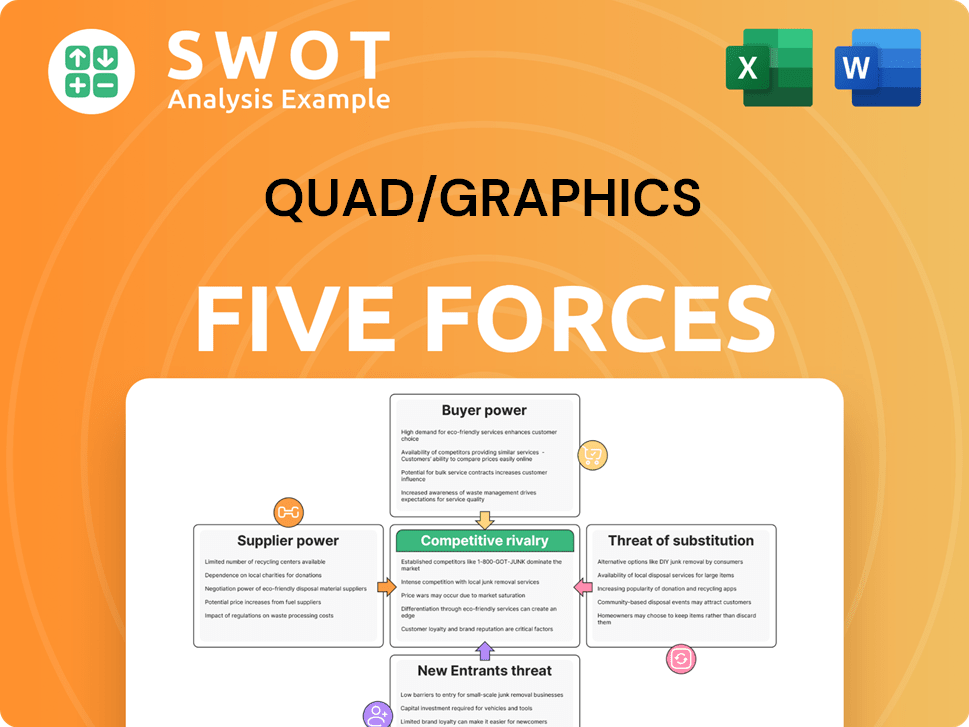
Related Blogs
- What are Mission Vision & Core Values of Quad/Graphics Company?
- What is Competitive Landscape of Quad/Graphics Company?
- What is Growth Strategy and Future Prospects of Quad/Graphics Company?
- How Does Quad/Graphics Company Work?
- What is Sales and Marketing Strategy of Quad/Graphics Company?
- What is Brief History of Quad/Graphics Company?
- What is Customer Demographics and Target Market of Quad/Graphics Company?
Disclaimer
All information, articles, and product details provided on this website are for general informational and educational purposes only. We do not claim any ownership over, nor do we intend to infringe upon, any trademarks, copyrights, logos, brand names, or other intellectual property mentioned or depicted on this site. Such intellectual property remains the property of its respective owners, and any references here are made solely for identification or informational purposes, without implying any affiliation, endorsement, or partnership.
We make no representations or warranties, express or implied, regarding the accuracy, completeness, or suitability of any content or products presented. Nothing on this website should be construed as legal, tax, investment, financial, medical, or other professional advice. In addition, no part of this site—including articles or product references—constitutes a solicitation, recommendation, endorsement, advertisement, or offer to buy or sell any securities, franchises, or other financial instruments, particularly in jurisdictions where such activity would be unlawful.
All content is of a general nature and may not address the specific circumstances of any individual or entity. It is not a substitute for professional advice or services. Any actions you take based on the information provided here are strictly at your own risk. You accept full responsibility for any decisions or outcomes arising from your use of this website and agree to release us from any liability in connection with your use of, or reliance upon, the content or products found herein.